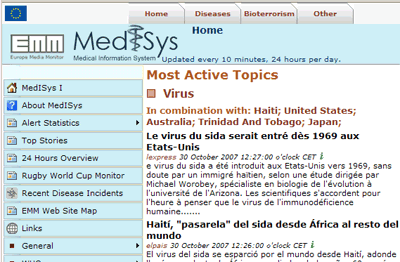me@tktl 07/07 |
Tietojenkäsittelytieteen laitoksen verkkolehti |
|---|---|
|
MedISys finds infectious disease from Internet |
In the globalized world, people and infectious disease with them travel quicker than ever, so there is a need for quick information about any cases of disease to prevent epidemics. So far European Centre for Disease Prevention and Control (ECDC) has monitored manually huge amount of internet sources. In Finland, National Public Health Institute (Kansanterveyslaitos) uses this kind of information.  In July 2006 Ralf Steinberger from European Commission's Joint Research Centre (JRC) visited the IIIA-2006 workshop in Helsinki. The role of JRC is, basically, to do research that the European Commission wants to get done. Among the things the Commission is interested in are security and health issues. Roman Yangarber had worked with issues related to monitoring disease cases already before he came to our department. He had a paper in the IIIA-2006 workshop and came to contact with JRC. -I am happy with the new partnership. At the moment it is a joint effort with no money changing hands, Roman tells and is applying for funding. Data and nice problems for Computer Scientists Traditional surveillance systems of health authorities monitor, for example, death rates and emergency room admissions. In addition, there are also some public or animal health threats which may go unnoticed by these sources but can be reported in the local press or by other less known sources. MedISys (Medical Information System) is meant to tackle the challenge of finding these news: it crawls the web and sorts information into categories. If the articles and keywords reveal a need, the system alerts automatically Public Health officials in standby across Europe by SMS or e-mail. The goal is to create an early warning system. With infectious disease, a delay of one extra day can needlessly expose people to serious threats. In addition to the need for speed, there are other challenges for computer scientists, too. A simple keyword search will meet certain problems that have to be solved: bird flu can be called avian flu or avian influenza and Vietnam is sometimes spelled Viet Nam, so MedISys just looks for documents based on keywords. The PULS system developed at our department extracts structured data from these documents: number of cases, the location and the date. This data is fed it into an automatic incident database. Are you working with an unsolved problem? - Yes and no. Most problems about language are so hard people have given up hope for finding perfect a solution any time soon. There is so much information so even an imperfect solution would help, Roman says. Also, the technology developed for MedISys can be adapted to other areas. And there is demand for monitoring sources in other languages than English. - One benefit is also that we really get huge amount of data, thousands of documents every day, which is good material for data mining and machine learning. See the public version of MediSys: http://medusa.jrc.it which also displays the latest incidents PULS finds. The complete PULS database is at http://doremi.cs.helsinki.fi/jrc/
Sanna Kettunen |
 |
|